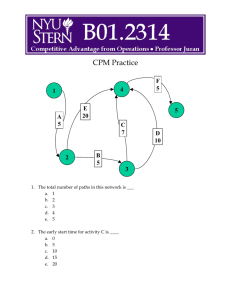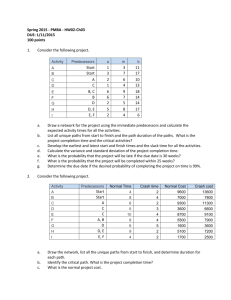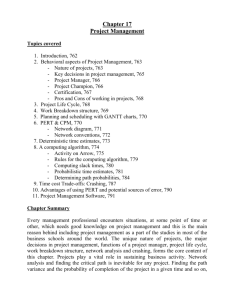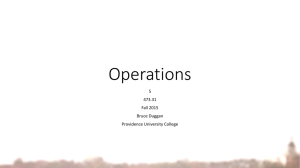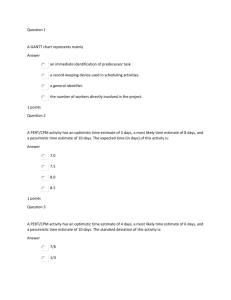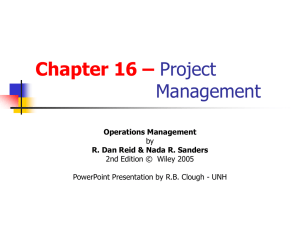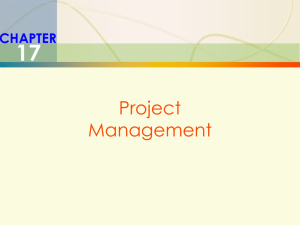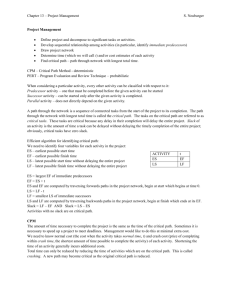spract-cpm
advertisement
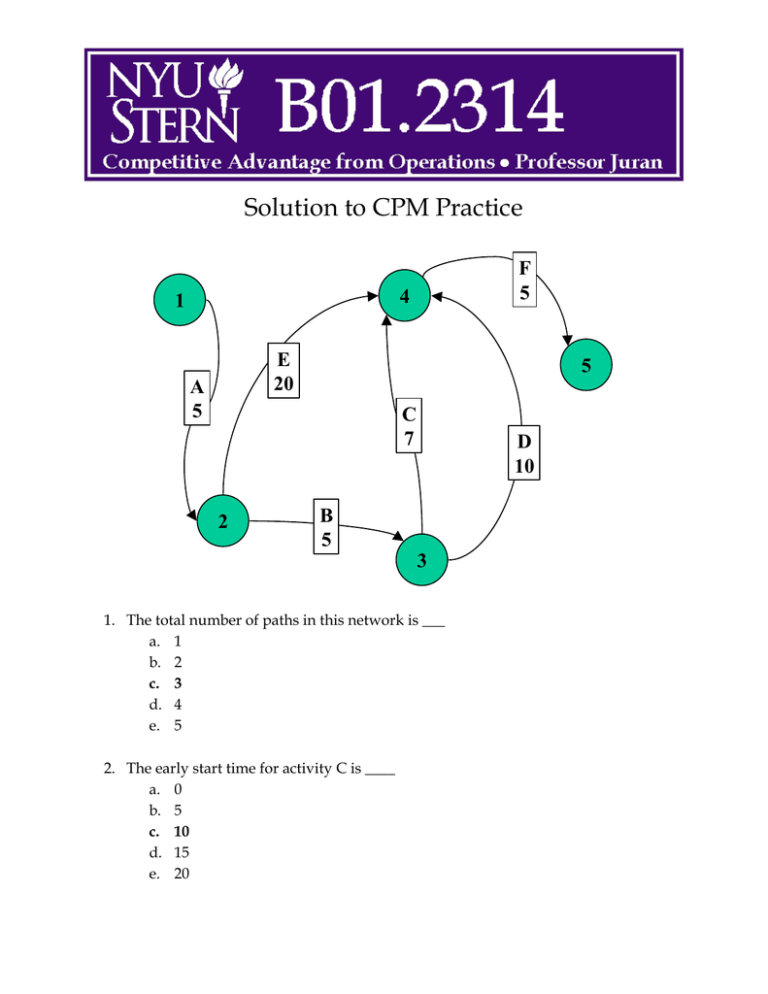
Solution to CPM Practice F 5 4 1 E 20 A 5 5 C 7 2 D 10 B 5 3 1. The total number of paths in this network is ___ a. 1 b. 2 c. 3 d. 4 e. 5 2. The early start time for activity C is ____ a. 0 b. 5 c. 10 d. 15 e. 20 3. The early finish time for activity D is ____ a. 5 b. 10 c. 15 d. 20 e. 25 4. The late finish time for activity B is ____ a. 5 b. 10 c. 15 d. 20 e. 25 5. Slack time for activity D is ____ a. 0 b. 5 c. 7 d. 8 e. 10 6. The critical path of the network consists of activities a. A-B-C-F. b. A-B-D-F. c. A-B-E-F. d. A-E-F e. A-B-C-D-E-F. 7. The length of the critical path is a. 20 b. 22 c. 25 d. 30 e. 52 8. (New problem, not related to Problems 1-7) If the pessimistic duration of an activity is 10 and the optimistic duration is 4, what is the variance for the activity time when using CPM analysis? a. 1 b. 2.333 c. 4.777 2 Operations Prof. Juran d. 10.4 e. 12 Estimated Activity Variance 2 Pessimisti c Optimistic 6 10 4 6 2 2 1 Below are the data for a Time-Cost CPM Scheduling analysis. The time is in days and the costs include both direct and indirect costs. Immediate Normal Crash Normal Crash Activity Predecessor Time Time Cost Cost A None 3 2 $200 $400 B A 4 3 $300 $600 C A 1 1 $300 $300 D B and C 3 2 $500 $550 E D 2 1 $500 $900 3 Operations Prof. Juran 9. If you crash this project to reduce the total time by four days, what is the total time of the project and total cost? a. Total time is 10 days, total cost is $2500 b. Total time is 9 days, total cost is $2300 c. Total time is 8 days, total cost is $2750 d. Total time is 8 days, total cost is $1850 e. Total time is 9 days, total cost is $2350 Normally we would have to use some sophisticated analysis to figure out a problem like this, but in this special instance it is fairly obvious what would have to happen for the project to be accelerated by four days. There are only four activities that can be “crashed”, and each of them only has one day of potential time reduction. Activity A B C D E Total $ $ $ $ $ $ Cost 400 600 300 550 900 2,750 Just for illustration, here’s how to set this up in HOM. First, we run the project with no crashing, and figure out that the “uncrashed” duration is 12. 4 Operations Prof. Juran Note: You need to go back and forth between your data sheet and the “parameters” window. The minimum duration and cost/time data can’t be entered unless you “enable cost crashing”. However, you don’t know the Desired Project Completion Time until you’ve run the model once without any crashing. The results of the “basic” CPM run: Critical Path Method Calculations Results. Activity Name ======== A B C D E Early Start ======== 0 3 3 7 10 Expected Completion Time : Early Finish ======== 3 7 4 10 12 Late Start ======== 0 3 6 7 10 Late Finish ======== 3 7 7 10 12 Slack ======== 0 0 3 0 0 12 Critical Path: A B D E Now, we enable crashing, set the desired completion time to 12 – 4 = 8, and run again: Activity Name ======== A B C D E Expected Completion Time Total Crashing Cost : Critical Path: A Crashed by ==== 1 1 0 1 1 : Cost of Crashing ==== 200 300 0 50 400 Present Duration ===== 2 3 1 2 1 D E Early Start ====== 0 2 2 5 7 Early Finish ====== 2 5 3 7 8 Late Start ====== 0 2 4 5 7 Late Finish ===== Slack ===== 2 5 5 7 8 0 0 2 0 0 8 950 B 5 Operations Prof. Juran Below are the data for a Time-Cost CPM Scheduling model analysis. The time is in days and the costs include both direct and indirect costs. Immediate Normal Crash Normal Crash Activity Predecessor Time Time Cost Cost A None 3 2 $200 $400 B A 4 3 $300 $600 C A 1 1 $200 $200 D B and C 3 2 $500 $550 E D 2 1 $500 $900 10. What are the total time of this project and total normal cost? a. Total time is 13 days, total cost is $1200 b. Total time is 12 days, total cost is $1700 c. Total time is 11 days, total cost is $1600 d. Total time is 10 days, total cost is $1750 e. Total time is 9 days, total cost is $1700 B 4 1 A 3 3 2 D 3 4 E 20 5 C 1 A simple project listing of five activities and their respective time estimates are presented below: Activity Immediate Predecessor Time in Days A None 1 B A 2 C A 1 D B and C 3 E D 2 11. Using the Single Time Estimate CPM procedure, which activities make up the critical path? a. A, C, D, E b. A, B, D, E c. A, C, B, D, E d. A, D, E e. None of the above 12. You ask your subordinates how long it will take to complete the job they are working on. The subordinates say, “If everything goes right it will take 6 hours, most likely it will take 8 hours, and if everything goes wrong it will take until the end of tomorrow or another 16 hours.” Since this job is a part of a larger project 6 Operations Prof. Juran you must estimate the expected time it will take to complete the job. Using the three activity time estimation procedure for CPM, what is the expected time for this job? a. 8 hours b. 9 hours c. 10 hours d. 11 hours e. 12 hours 13. You are working on a project that has 12 activities and want to perform a CPM analysis on the project. You determine the critical path consists of only five activities. You then compute the variances for the five critical path activities and these variances are 3, 4, 2, 1, and 6 days. If the desired completion date for the project is 50 days and the expected completion date for the project is 40 days, what is the probability that the project will be completed by the desired completion date? a. 0.99379 b. 0.99180 c. 0.99772 d. 0.91924 e. 0.67364 7 Operations Prof. Juran
